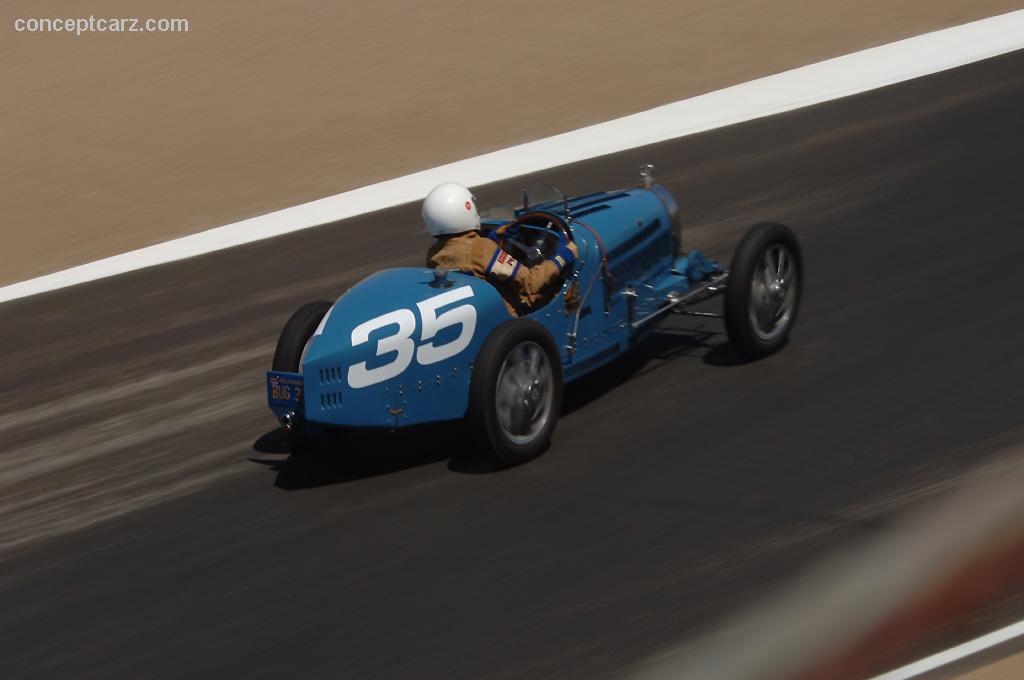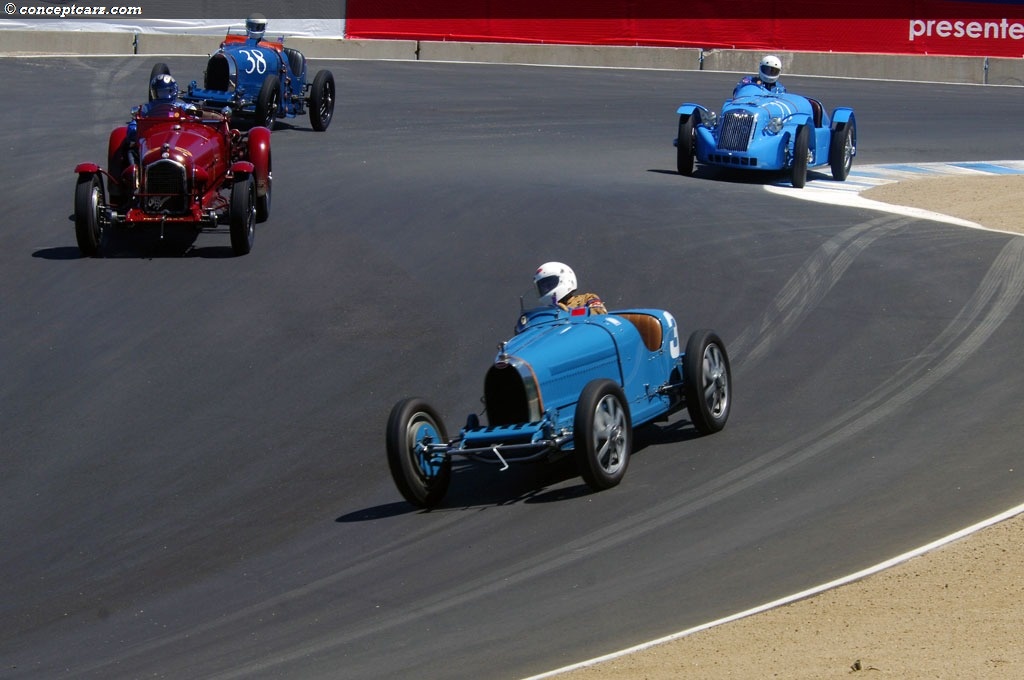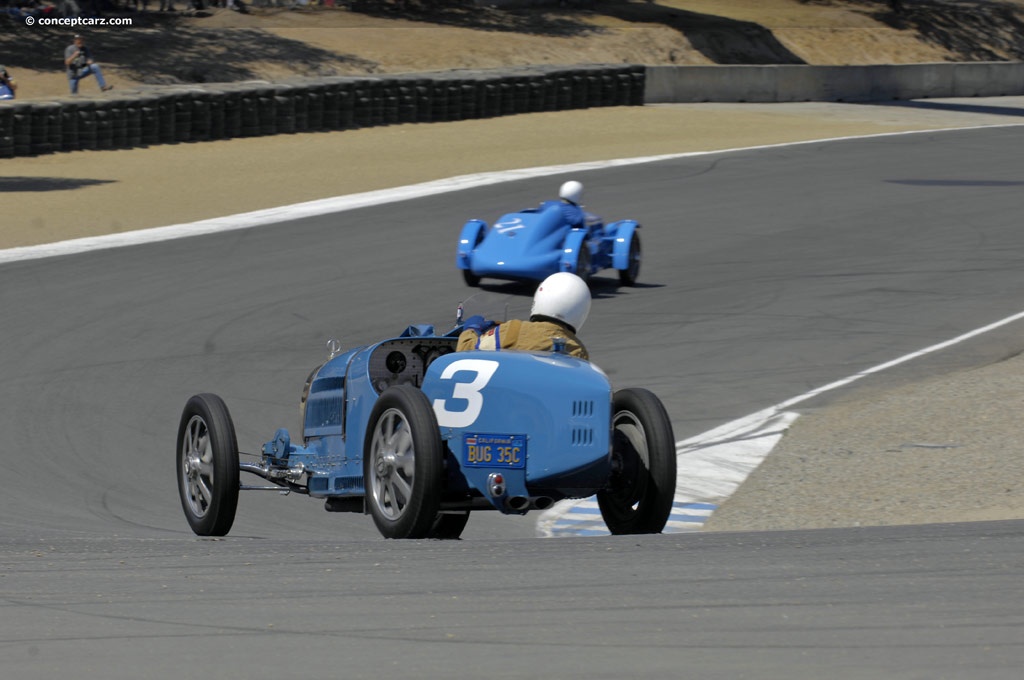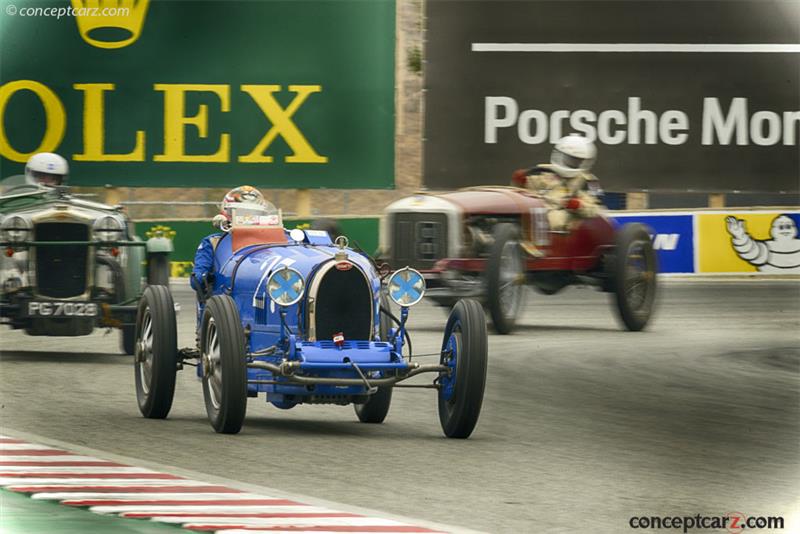Brilliant engineering, sculptural coachwork, and a sophisticated engine resulted in the very successful Bugatti Type 35 Grand Prix cars. It was relatively diminutive and very maneuverable, especially on the short tracks of the 1920s, and a perfect blend of power and weight. 
Grand Prix
Chassis #: 4596
View info and historyCombining a short and lightweight chassis, a low center of gravity, and a potent 1,991cc SOHC inline-8 cylinder engine, the Type 35 Bugatti was one of the most dominant participants in Grand Prix motorsport racing during the 1920s. For example, at the 1930 Monaco Grand Prix, nearly sixty percent of the starting grid were Type 35s. During its racing career, it would achieve nearly 1,800 racing victories. The Type 35 won the Targa Florio for five consecutive years, from 1925 through 1929, and it won the Grand Prix World Championship in 1926. Production
Produced from 1924 to 1930, the Type 35 was continually updated, improved, and modified during that time.Type 35
- Approximately 96 examples of the non-supercharged Type 35 were produced.
- Approximately 139 examples of the Type 35A were produced.
- Approximately 13 examples of the Type 35T were produced.
- Approximately 45 examples were Type 35C.
- Approximately 37 were Type 35B.
Grand Prix
Chassis #: 4572
Engine #: 50
View info and history
Auction entries : 1Type 37
- Approximately 223 examples of the Type 37 were built.
- Approximately 57 examples were supercharged Type 37A models.Type 39
Bugatti produced approximately 10 examples of the Type 39, including the supercharged Type 39A.Mechanical Specification
The Bugatti Type 35 had a 94.5-inch wheelbase, an overall length of 144.9 inches, a width of 52 inches, and weighed around 650 to 750 kg. Resting behind the iconic horseshoe radiator was an evolution of the 2.0 liter (1991cc), three-valve, overhead cam straight-eight engine first used in the Type 29. It had a 60mm bore, an 88mm stroke, a sophisticated five main roller bearing system, and a rev limit of around 6,000 RPM. In naturally-aspirated configuration, the engine produced approximately 90 horsepower.
Grand Prix
Chassis #: 4596
View info and historyThe Type 35 had cable-operated drum brakes, alloy wheels, and a hollow front axle which helped reduce unsprung weight. Instead of U-bolting the springs to the front axle, they passed through it, and this feature would become a Bugatti trademark used on many future models. Bugatti Type 35C
Ettore Bugatti preferred naturally aspirated engines, but when his customers requested higher specifications and more power, superchargers were one of the quickest and easiest means of extracting more performance. Bugatti introduced the Type 35C in 1926 featuring a Roots-Type supercharger which increased engine output to 128 horsepower. The Type 35C quickly demonstrated its racing potential as it placed first and second in its inaugural outing - the 1926 Milan Grand Prix held at Monza. Bugatti Type 35T
The Bugatti Type 35T received a 2.3-liter (2,262cc) engine with a 100mm stroke and was intended for use in the 1926 Targa Florio. Due to its larger engine displacement, these modls were unable to compete in Grand Prix competition (limited to 2.0 liters).Bugatti Type 35B / 35TC
Bugatti called its most powerful version of the Type 35, the 'Type 35TC,' short for Targa Compressor, but it was known colloquially as the 'T35B.' Its engine was the same as the one lurking beneath the bonnet of the Type 35T, but with a large supercharger and an output of 138 horsepower.
Grand Prix
Chassis #: 4570William Grover-Williams drove a Type 35B to victory at the inaugural 1929 Monaco Grand Prix. Although powerful and developed high levels of torque, the fuel consumption was not as good as the Type 35C, and it did not rev as high. Eventually, the factory reverted to producing the T35C. Bugatti Type 35A
The Bugatti Type 35A was a detuned version of the Type 35 Grand Prix racer. They were intended for fast touring while offering relative ease of maintenance and operation, thanks in part to the plain bearings on the crankshaft, smaller valves, and coil ignition. Wire wheels were commonly fitted at all four corners.
Grand Prix
Chassis #: 4572
Engine #: 50
View info and history
Auction entries : 1
Bugatti Type 37 and Type 37A
The Bugatti Type 37 had the same chassis and bodywork as the Type 35, wire wheels, and was powered by a new 1.5-liter (1,496cc) straight-4-cylinder engine. The SOHC three-valve unit produced 60 horsepower and was easier to maintain for many privateers. The supercharged version (Type 37A) produced upwards of 90 horsepower and came with larger brake drums. The 1.5-liter engine used by the Type 37 was later used in the Type 40.Bugatti Type 39
The Type 39 and Type 35 were identical, except that Type 39 had a smaller stroke (66 mm), a mix of plain and roller bearings, and a modified crankshaft. Its displacement was slightly smaller than the Type 35, measuring 1,493cc. A single 1,092cc example was built, which had a bore size of 51.3mm.
by Daniel Vaughan | May 2024

Grand Prix
Chassis #: 4596
View info and history
Produced from 1924 to 1930, the Type 35 was continually updated, improved, and modified during that time.Type 35
- Approximately 96 examples of the non-supercharged Type 35 were produced.
- Approximately 139 examples of the Type 35A were produced.
- Approximately 13 examples of the Type 35T were produced.
- Approximately 45 examples were Type 35C.
- Approximately 37 were Type 35B.

Grand Prix
Chassis #: 4572
Engine #: 50
View info and history
Auction entries : 1
- Approximately 223 examples of the Type 37 were built.
- Approximately 57 examples were supercharged Type 37A models.Type 39
Bugatti produced approximately 10 examples of the Type 39, including the supercharged Type 39A.Mechanical Specification
The Bugatti Type 35 had a 94.5-inch wheelbase, an overall length of 144.9 inches, a width of 52 inches, and weighed around 650 to 750 kg. Resting behind the iconic horseshoe radiator was an evolution of the 2.0 liter (1991cc), three-valve, overhead cam straight-eight engine first used in the Type 29. It had a 60mm bore, an 88mm stroke, a sophisticated five main roller bearing system, and a rev limit of around 6,000 RPM. In naturally-aspirated configuration, the engine produced approximately 90 horsepower.

Grand Prix
Chassis #: 4596
View info and history
Ettore Bugatti preferred naturally aspirated engines, but when his customers requested higher specifications and more power, superchargers were one of the quickest and easiest means of extracting more performance. Bugatti introduced the Type 35C in 1926 featuring a Roots-Type supercharger which increased engine output to 128 horsepower. The Type 35C quickly demonstrated its racing potential as it placed first and second in its inaugural outing - the 1926 Milan Grand Prix held at Monza. Bugatti Type 35T
The Bugatti Type 35T received a 2.3-liter (2,262cc) engine with a 100mm stroke and was intended for use in the 1926 Targa Florio. Due to its larger engine displacement, these modls were unable to compete in Grand Prix competition (limited to 2.0 liters).Bugatti Type 35B / 35TC
Bugatti called its most powerful version of the Type 35, the 'Type 35TC,' short for Targa Compressor, but it was known colloquially as the 'T35B.' Its engine was the same as the one lurking beneath the bonnet of the Type 35T, but with a large supercharger and an output of 138 horsepower.

Grand Prix
Chassis #: 4570
The Bugatti Type 35A was a detuned version of the Type 35 Grand Prix racer. They were intended for fast touring while offering relative ease of maintenance and operation, thanks in part to the plain bearings on the crankshaft, smaller valves, and coil ignition. Wire wheels were commonly fitted at all four corners.

Grand Prix
Chassis #: 4572
Engine #: 50
View info and history
Auction entries : 1
Bugatti Type 37 and Type 37A
The Bugatti Type 37 had the same chassis and bodywork as the Type 35, wire wheels, and was powered by a new 1.5-liter (1,496cc) straight-4-cylinder engine. The SOHC three-valve unit produced 60 horsepower and was easier to maintain for many privateers. The supercharged version (Type 37A) produced upwards of 90 horsepower and came with larger brake drums. The 1.5-liter engine used by the Type 37 was later used in the Type 40.Bugatti Type 39
The Type 39 and Type 35 were identical, except that Type 39 had a smaller stroke (66 mm), a mix of plain and roller bearings, and a modified crankshaft. Its displacement was slightly smaller than the Type 35, measuring 1,493cc. A single 1,092cc example was built, which had a bore size of 51.3mm.
by Daniel Vaughan | May 2024
Related Reading : Bugatti Type 35 History
The Bugatti Type 35 is regarded by many as one of the most beautiful pre-war racers from the legendary Bugatti Company. Its beauty is matched by its accomplishments, is one of the most successful pre-war racer winning over 1000 races and capturing the 1926 Grand Prix World Championship with 351 races. During that two-year period, it also claimed 47 records. From 1925 through 1929, the Bugatti Type....
Continue Reading >>
Continue Reading >>
THE LEGENDARY BUGATTI TYPE 35 – THE WORLD'S MOST SUCCESSFUL RACING CAR
Light, strong, fast and elegant. The Bugatti Type 35 is one of the most successful racing cars of all time. And deservedly so the French manufacturers open-top sports car secured over 2,000 victories between 1924 and 1930. Today, the Type 35 is a legend in international motor sport. And a whole lot more besides. The Bugatti Type 35 is one of the icons of Bugattis rich history and tradition.....
Continue Reading >>
Continue Reading >>
Similar Automakers
Similarly Sized Vehicles
from 1925
1925 Bugatti Type 35C Vehicle Profiles
Recent Vehicle Additions
Performance and Specification Comparison
Type 35C Specification Comparison by Year
Year
Production
Wheelbase
Engine
Prices
Related Automotive News

Bugatti Chiron Sport 'Les Légendes du Ciel' meets Dassault Rafale Marine: A match-up of Two Superlatives
Two machines at the pinnacle of engineering – the Bugatti Chiron Sport and the Dassault Rafale Marine – face each other at a naval base in Landivisiau, north-west France. The ultimate high-octane rendezvous between Frances top machines is a spectacle...

Bugatti Legends Type 41 LA Royale – A Royal Vehicle
In the 1920s, Bugatti created the most luxurious car in the world
Molsheim, 09 04 2020 With the Type 41 Royale, in 1926, Bugatti presented the strongest, largest and most luxurious automobile in the world, characterized by unimaginable...

Bugatti Baby II Revealed At Bugatti's 110Th Anniversary
Prototype Baby II test driven by customers at the brands 110th anniversary in Molsheim
Molsheim, 18 September 2019. For the celebration of the 110th anniversary of Bugatti, a very special surprise was prepared for the enthusiasts of La...

Bugatti Baby Reborn: A 110Th Surprise Birthday Present
500 limited-edition junior Bugatti cars built to celebrate the brands 110th anniversary
The car that brought Automobiles Ettore Bugatti to fame in the 1920s, the Bugatti Type 35, is generally acknowledged as the most successful racing car of...

Extremely Significant, Early Shelby Cobra Roadster an Exceptional and Early Headline Consignment to Russo and Steele's Upcoming Monterey Auction
Scottsdale, Arizona – With his AC Ace-derived, Ford-powered Cobra, Carroll Shelby and his racing team spearheaded Fords Total Performance campaign of the 1960s on the world stage and ended Ferraris dominance of the World Sportscar Championship for...




































